Cady North's Blog
May 6, 2024
The Art of the Sabbatical is Here
I wrote The Art of the Sabbatical because the nature of work is changing. We’re far removed from a time when you work for the same organization for 35 or 40 years and then retire. It’s now common to have almost 9 jobs before the age of 35, according to the Bureau of Labor Statistics.
Why does society tell us to work, work, work then retire? It doesn’t make sense.
It makes more sense that we might like to rest, celebrate, transition, or switch gears multiple times during our lifetime. But we haven’t been taught to take breaks. In fact, they can feel uncomfortable.
A vacation won’t do. You need to shift your priorities and perspectives with many weeks or months off from work.
The Book is HereI’m proud to announce The Art of the Sabbatical is now published and available for purchase. It’s a guidebook to lead you through the financial and mindset strategies you can use to plan a transformational work break.
If you’re burned out but don’t think a break is possible, this book will help you figure out where to begin planning.If you’re thinking about a mid-career change, this book will help you use your sabbatical to explore possibilities.If you’re dreaming of retirement, a sabbatical could be a way to “test the waters” to see what eventual retirement might be like.If you want ideas to “practice” taking a sabbatical or get the feeling of taking a break without actually leaving your job, this book will also have tips for you.In my work as a financial planner, I’ve coached dozens of people one-on-one to help them take a hiatus from work. And I can tell you from experience, it’s never the finances that are the MOST fear-inducing. It’s often intrusive, emotional reactions which can be the most challenging. It’s very easy for us to craft an identity around our work or job, and it takes effort to let go of your career identity, even temporarily.
My StoryI have first-hand experience. Before starting my financial planning firm in 2015, burned out and overworked, I left my corporate job without a real plan or timeline, just a loose idea I wanted to pivot to working in personal finance. I liked telling people I was taking a sabbatical because, for me, it meant the work break was somehow “sanctioned” or serving as a bridge to whatever came next. The reality was I had left a high-paying media job and didn’t know when or where my next real paycheck would come from. I also didn’t know when or how I would get to my next thing. That’s a scary situation for anyone.
When I took my sabbatical, it gave me unstructured space to slowly explore building a business that now, eight years in, is successful and thriving. Moreover, my sabbatical taught me to tolerate a different way of working, one that isn’t filled with daily emergencies and mini-crises. It also taught me to build-in balance, days off, and time to explore creative hobbies and interests.
I want that for you, too.
What’s in the BookA sabbatical can take many shapes, forms or colors. So in this book, we will examine success catalysts gleaned from others’ stories. I’ve interviewed dozens of people and gotten their take, so you get the first-hand knowledge from people of different walks of life. Hint: it’s more “art” than science. We’ll explore why sabbaticals are so essential and what current offerings exist to take one. Sometimes they are paid or unpaid. Sometimes there’s support from your place of work, and sometimes you need to do it on your own (i.e a “self paid sabbatical”).
Your fears about taking an extended work break (whether related to the future, family, or finances) can be petrifying. So we’ll tackle those fears head-on and share ways of overcoming them. Then, we’ll look at some key success factors and explore methods of synthesizing what you’ll learn while away from work. Incorporating those learnings into your life and work will be important moving forward.
Finally, no matter where you are in your decision-making or planning, we’ll give you some actionable insights, stories and even journal prompts. We’ll fill up your palette so you can color in your sabbatical journey. This is where the art of the sabbatical comes in.
The post The Art of the Sabbatical is Here first appeared on Cady North.
September 5, 2023
Living Life Like a Sabbatical
Nature can’t grow all year long. There are periods of growth followed by a pause and finally renewal, when the process of growth starts over again. It should be the same with us, but we are constantly trying to deny our natural tendencies for rest and renewal. Sabbaticals, can be that important pause that kicks off a new period of growth and change.
But what happens if this just isn’t feasible right now? When saving is just not possible or taking time off would mean that it would create a huge gap in care for your family, think about ways you could capture the same feeling as being on a sabbatical. The time you devote to it and what you do specifically to rest and renew might look different from your neighbor, but there are some key ways you can experiment.
For me, it’s all about switching things up by season, staying active, and enjoying where I live. In the last few years I’ve been striving to live my life like adult summer camp as a way to get into the spirit of a sabbatical without taking extended leave from my business. I can lean into this even more after a busy period at work. To do this, most weeks I include a component of physical activity, nature, water activity, and arts and crafts in my day-to-day life.
Even if I can’t include all of these in a given week, the energy I get from the activities I can fit in tends to carry me through to the next week. I don’t like things to get too stale, so while some weeks may look very similar, during the course of a month or two, I might change up one or two of the components. Summer is for sailing and being in the ocean, while winter is for tide pooling and hiking.
The curious thing about my adult summer camp experiences—I often come back to work with a new sense of self and I feel less blocked. Sometimes while I’m doing a completely unrelated creative task, my brain solves a work problem in the background. Instead of viewing these adventures as time wasters (or ways to procrastinate on work) I’ve shifted to view them as a necessary part of making me effective at my job. The idea is to life more of my every day life like I’m always on sabbatical.
If the idea of adult summer camp works for you, run wild!
Pottery is My Current Arts and Crafts Go-toIn the last year and a half I’ve gotten into wheel throwing pottery. One of my favorite things to do is make bud vases. I have a fun little collection of them now. It gave me a great idea, “What if I featured a bud vase on each chapter of my new book, The Art of the Sabbatical?”
So I’ve got twelve of my favorite vases, one for each of the twelve chapters tackling the mindset and money behind planning a transformative work break.
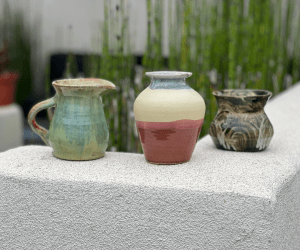
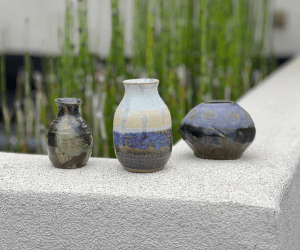
And then I thought, “Maybe other people would love these vases as much as I do!”
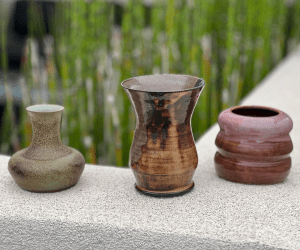
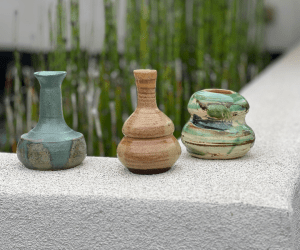
So, now I’m making them available as part of my presale campaign for the next 30 days.
Rest and Renewal at WorkAs you might have guessed, it’s not just about what you add into your free-time, changing your relationship to work is going to be important if you want to start feeling more sabbatical-like. Here are some ideas to try:
Re-align your time boundaries at work (when you work, days you work, location you work).Ask for help with some of your responsibilitiesAsk your boss for extra personal days or partial workday day here and thereIntentionally reduce some of your responsibilities (home and work) on a temporary basisTrain a back-up at work; it’s important to develop new talent and create succession plans.Take actual vacation days and commit to truly unplugging while not workingA sabbatical is a great proving ground to learn how to be more comfortable with unstructured time, but a sabbatical isn’t the only way to train yourself to love having less on your to-do list.
“Our brains crave unstructured time to wander, ponder deeply, find new sparks or just rest,” Allison Holzer, shared in a blog post. As the author of Dare to Inspire: Sustain the Fire of Inspiration in Work and Life, Allison explored this topic and has learned to value and prioritize unstructured time in her life as a specific strategy that supports her work coaching executives.
Weekly she blocks out one, two-hour period with no pre-determined structure or activity. She sometimes listens to a podcast or takes a walk. But the one rule is to “stay away from devices that would trigger my need to immediately respond and produce.”Monthly she blocks out an entire day for discovery or self care. It could be lunch with a friend, getting a facial, attending a thought-provoking conference or devoting a day to read or learn about a new topic.Quarterly she schedules a long-weekend for vacation with family. Some portion of that weekend will include family activities, but she also prioritizes recharge time alone too.What do you do to add more ease and peace into your daily life?
The post Living Life Like a Sabbatical first appeared on Cady North.
July 12, 2023
Work Has Changed But Our Norms Have Not
Most workers are no longer employed in the manufacturing sector, according to Bureau of Labor Statistics. Yet, we still follow productivity standards honed during an age when the majority of workers were employed in farming or manufacturing. Examples include measuring output, efficiency, mistake prevention and comparing one time period (or one company) with another.
We now work in a “knowledge economy”—in professional services like law, health, finance or tech, in which new ideas and creativity are prized and repetitive tasks can be outsourced to machines. But companies still urge workers to comply with metrics, objectives and key results (OKRs) and key performance indicators (KPIs) often tied to their productivity.
“How can we do more with less?” is often asked of us. It’s enough to put pressures on even the most productive knowledge workers.
The impact of this productivity-focused approach has shown up in research. A 2015 Deloitte Study discovered that 77 percent of respondents experienced burnout in their current positions (Deloitte 2015). Some clues you’re experiencing burnout include feeling depleted or exhausted much of the time, experiencing cynicism, having a quick anger fuse, and/or being less effective or more prone to depression symptoms at work.
When we do knowledge-based work—that is work based around ideas, creativity, focus, writing, or people—we need restorative time during and after our work day. When we don’t allow time to recharge and reflect in an unstructured way, it kills our drive and stifles our energy to move forward. Corporate life just isn’t designed for this type of recharge time and it’s not celebrated or cultivated enough. It’s not common to have “rest metrics,” only productivity metrics. Throw in constant strategy changes, reorganizations, and unclear communication from leadership and it’s a recipe for disaster for employees. Until these pressure-inducing work norms are addressed, burnout will continue to be a major issue in all sectors.
In my first book, “The Resiliency Effect,” I explored how the epidemic of workaholism and hustle culture keep us from the big things we want to do in life. Being busy and achievement focused is a coping mechanism. It can be a good way to maintain self esteem (or cope with other problem areas in our personal life) but unfortunately this road can lead us straight to overwork and suffering. That book further explores the root causes of some of these coping mechanisms and I share journal prompts and concepts to help facilitate change in yourself.
But I’ll be the first to admit, it’s hard to find to the time to do the necessary inner work to explore and remove these obstacles—which are often emotional in nature.
It definitely takes changing your values and priorities to do this hard work, as well as time. What greater time to do it than on a break or sabbatical from work?
We need to normalize work breaks! And people need to know *how* to take a fruitful break. My second book, The Art of the Sabbatical (working title) will tackle these things and more.
Extended work breaks seems like a dream! But nearly everyone thinks taking an extended break from work will be detrimental to their career, family, or financial lives. Based on my experience and research, extended work breaks (not just vacations) are the best catalyst to discover, learn and grow professionally and personally.
Stay tuned, there’s more to come.
November 22, 2021
What Do You Need to Unlearn to Be Successful?
A mentor said to me one day, “Developing your mindset is actually about unlearning behaviors.” That really stuck with me.
And if there’s one thing I learned from talking with dozens of people for my book is that all of us go through quite a bit of UNlearning as we take our lives and careers to the next level. When we focus only on life hacks, learning new skills and certifications, and to-do lists our brains get too filled and we forget to let go of what no longer serves us.
Without a specific intention, I’d been focusing on unlearning lots of behaviors since becoming an adult. Many of the behaviors had been coping mechanisms that protected me as I went through so much as a kid and young adult. Before doing this work, I often focused too much on the negatives in life. I also put a lot of pressure on myself to learn everything on my own because it was a sign of weakness to ask for help.
It got me thinking, what are some key things we can spend time un-learning to put us in a better mindset to accomplish our dreams?
Asking for Help ≠ WeaknessIn The Resiliency Effect, I interviewed an entrepreneurial-minded woman named Vanessa Mason. She has a background in public health and even co-founded a venture capital firm that invests in up-and-coming companies changing the public health landscape. Before she landed her current job at the Institute for the Future, she owned a small consulting business for five years.
Rather than staying in corporate jobs that weren’t meeting her needs, she decided to start a consulting business on her own in 2013. Vanessa said to herself at the time, “You learn by doing, not just thinking or analyzing what it would take to do something big.” Since she had been successful picking up contracting projects in some of her other professional roles, she thought she had enough experience to go out on her own.
She knew she needed to give it at least 18 months to start because it would take at least that long to become profitable. Managing to pick up some big-name projects in the public health and tech sectors, Vanessa enjoyed the freedom of being on her own. However, as she continued in her entrepreneurship journey, she found herself focused on cash management and the bottom line, which took away from her ability to think strategically and get help in areas she was weak in. Those old habits of needing to do everything on her own were creeping back in.
Things came to a head when she found herself depressed, and unable to give the business the full attention it deserved with less revenue coming in than she wanted. What Vanessa learned from the experience was that you have to ask for help and take it. If she were to do it again, she said, “All of my resources should have been protecting my time rather than trying to do things all on my own. I thought how much I was doing was a measure of success, not what I was building.” Basically, she would focus on un-learning this coping mechanism of feeling like she has to do everything on her own.
Achievement ≠ Self EsteemA big theme throughout my book has been about how achievement and over-functioning is the enemy of us. It works against our physical and mental health and creates the hamster wheel that’s hard to remove ourselves from unless or until we completely burnout.
In my own life — it took burnout to finally listen and I realized that my need for achievement was what helped me feel like I was worth something. Leaving my job and taking a sabbatical helped reset this expectation in me so I could focus more on a being a human being instead of a “human doing”. It also helped me to reset my expectations for myself and for my business — which was a new creative endeavor that I found space for only after getting off the hamster wheel of full-time corporate work.
Risk ≠ Always UnsafeAnother woman I interviewed in my book shared about how launching her entrepreneurial journey required her to let go of the fear of risk. Dr. Annemarie Spadafore was taught all her life to find a “safe job” that would suit her well. He grandfather had been an entrepreneur and an early death created trauma for her father’s family. The message to seek safety and security first was passed down to her.
She had a long career in government service before sitting down with a coach to take a career assessment. The results showed that “financial security” ranked lower for her than freedom in her life and career. She realized, “I’d rather move to a cabin in the middle of nowhere and scrape by while working for myself than work for someone else. I’m willing to make huge lifestyle changes just to keep the independence of working for myself.”
In fact, taking this coaching assessment is what opened her eyes to getting her own coaching certification. At first this was an add-on that helped her in her government role, but later became what allowed her to launch her own coaching business.
She describes her unlearning journey as one that has many layers. She often tested the waters before making big leaps.
Thankfully, she hasn’t had to make big lifestyle cuts in order to grow her business, called Powerlab, while maintaining her freedom. When she looks back on it, she never really wanted those government jobs because the bureaucracy bothered her. Yet, she was more than willing to endure the frustration of bureaucracy because she wasn’t ready to give up on that need for “safety.” Now the desire for freedom and flexibility has fully eclipsed the fear of risk and desire to seek out safety and stability. This reframing is what allowed to her to unlearn that risk is not always unsafe.
There’s No Such Thing as Negative EmotionsKeeping feelings deep down inside — especially anger is both societally reinforced and likely something that was modeled in our families. For instance, I viewed all anger as bad growing up, I didn’t even feel like I could express frustration with a work issue. I wasn’t a doormat, but rather if things got bad enough I would “cut and run.” Emotions would finally boil over and I would end the relationship or quit the job. There was no middle ground.
I had to unlearn that anger was a “bad” thing. I had to find ways of tapping into my anger and releasing it appropriately. A book called, Facing the Fire, by John Lee was instrumental in giving me tools like wringing a towel, punching a pillow, or screaming in the car. These activities which once seemed overly violent, scary or unnecessary to me, helped me understand that I was harboring much more anger than I could’ve imagined. These “safe” ways of expressing anger don’t hurt others, so I was able to use these tools to discharge all the energy associated with my anger. Keeping all these feelings locked away for years was affecting me in all sorts of ways and prevented me from discovering my true potential.
I came to appreciate that all emotions are human emotions — none are good or bad. They exist for a reason, especially as indicators of what is happening to us or around us. However, they don’t have to rule us.
Exploring some of the “negative” emotions and unlearning that they were bad made a huge difference in my interpersonal relationships and my ability to find contentment in my work and with myself. This tool even helped with accepting and relating to my anxiety – which I can now often “say hello” to whenever it pops up, kind of like an old friend, and then ask myself, “What’s this feeling related to?” Before unlearning that anxiety was a bad thing, feeling it would send me into a huge worry-storm which would only reinforce and make the anxiety, and the inability to breath, worse.
To find success, it’s more important to unlearn coping mechanisms. Most of the time, our initial instincts such as pushing down our feelings, pursuing security over passion, or a fear of sharing our dreams with those around us are there to protect our old selves from getting hurt again.
It’s important to appreciate those protective instincts for what they are — coping mechanisms that kept us safe in the past. Then, we can actively choose to unlearn them since they often create roadblocks to us achieving our biggest dreams.
September 29, 2021
Great Resignation or Burnout Epidemic?
By now, you’ve seen the surveys: anywhere between 25%-40% of employees are considering leaving their jobs this year. In my work with private financial clients, I’ve seen this trend too. Because of the pandemic many of us are are questioning life decisions, living arrangements and careers.
If you’re in this boat, one of the next natural thoughts you might have is, “How can I get away from it — this soul sucking job — and do something I like more?” Often people feeling this pull have no idea what they will do next. So the fear that comes next shows up in full force, “I don’t actually know what I want and I’m scared to leave my job when I don’t have the next steps planned out.”
As I’ve written about in my book, I myself experienced a recharge and redirected my life and career after taking a sabbatical. I coach a significant portion of my financial planning clients through taking a sabbatical by choice as well. I can definitively say, the plan for “what’s next?” doesn’t have to be fully formed before you’re ready to take a work break, but there are steps you need to make sure you can afford the time off.
All this is well and good — but let’s take a step back for a second to examine the real reasons why so many of us have a desire to leave our jobs in the first place. It’s actually the burnout epidemic.
While I was writing my book, I dug into the causes of burnout and found there are a few major influences. These include the systemic effects of capitalism and employers slow to move from the now archaic cultural and operational norms from when manufacturing was the dominant driver in our economy (versus the knowledge dominant economy today). But more likely the root cause is trauma and adversity in our own life or from generations past. For some people, these experiences that happened in our lifetime or that of our ancestors, can lead us to feel worthless unless we’re achieving. Needing to find validation through work and achievement is a completely societally acceptable method of engaging. Many of us have gotten really good at all the juggling as long as it feeds the achievement beast. Checking off your to-do list, after all, can be one of the most satisfying parts of many peoples’ day.
An article was recently published in Refinery 29 examining some of the more immediate reasons we are all collectively coming to terms with the epidemic of burnout across industries. It’s not just exhaustion, it’s overwhelm at the system.
One aspect I found particularly interesting is that this didn’t happen overnight or in one generation. Doctors, for instance, experience subtle “betrayals” as they go through training and the early years of the profession by mentors, teachers, and colleagues awakening to the fact that they probably can’t be the perfectly kind and empathetic professional they wanted to be. These little betrayals are further perpetrated by the institutions they work for, the weight of student debt, and more broadly the the healthcare and insurance systems.
Work, today, is failing to live up to the expectations we had of finding passion and purpose in what we do while getting paid well. There’s room for institutions to reform the world of work. But in the meantime we have our own individual work to do. But there’s often guilt associated with leaving a “good” job. In my book I refer to this as “golden handcuffs.”
We might have a conversation like this in our head — “I can do this job, it’s not that hard, and if I don’t take it too seriously I can work on other passion projects on the side.” or “How can I give up these well paid role when I don’t know what to do next?” But all the while, a need to feel fulfilled through work isn’t being addressed. Have we even asked ourselves this particular “why” question enough times to arrive at the core of what’s going on in our brains?
That’s why I include so many journal prompts in The Resiliency Effect. We all must take steps to go through our own inner journey to discover for ourselves where these needs come from and which of these needs have a place in our current self.
Without this inner journey, I’m afraid when we finally find the next job, next career, or next work break it’ll be for similar reasons including overwhelm and burnout.
Cady North, CFP® RLP® is the author of The Resiliency Effect and financial planner to women across the country through North Financial Advisors.
August 16, 2021
Goodreads Ebook Giveaway
We just launched an exciting giveaway on Goodreads. Enter to win 1 of 100 FREE Ebooks! This is an inspirational summer read — find out how to create lasting resilience in your life or even take a work sabbatical. Don’t miss this opportunity to grab a copy, the giveaway window expires August 30.
As one Amazon user said: “This book teaches readers how to be resilient through some of life’s hardest lessons. Author Cady North shares great insight on financial planning, psychology of human behavior, and entrepreneurship to help her readers get in sync with their life’s purpose and passions. Highly recommend!”
Goodreads Book Giveaway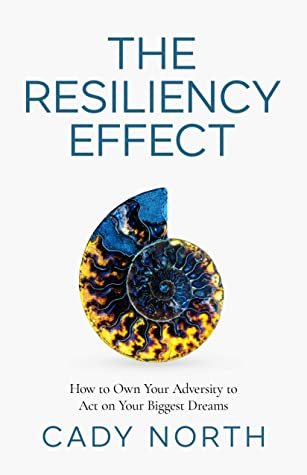 The Resiliency Effectby Cady North
The Resiliency Effectby Cady NorthGiveaway ends August 30, 2021.
See the giveaway details at Goodreads. Enter Giveaway
July 22, 2021
Cady North Featured on the Female Founders Network Podcast
Cady North had the opportunity to sit down with Nat Brown and Sylvie Hall of the Female Founders Network Podcast to talk about all things entrepreneurship and financial resilience. This podcast is great for those navigating business ownership, leadership and life. Give it a listen here.
June 17, 2021
Access a Free Preview of The Resiliency Effect Audiobook
The Audiobook version of The Resiliency Effect is published and available now on Audible, Amazon and everywhere you consume audiobooks. Check out a free preview from the audiobook here.
April 2, 2021
Goodreads Giveaway
We just launched an amazing giveaway on Goodreads. Enter for your chance to win one of 10 personally autographed paperback copies of The Resiliency Effect. Winners announced April 26. Start your spring off with an uplifting read about how to start living more of the life you should be living.
Goodreads Book Giveaway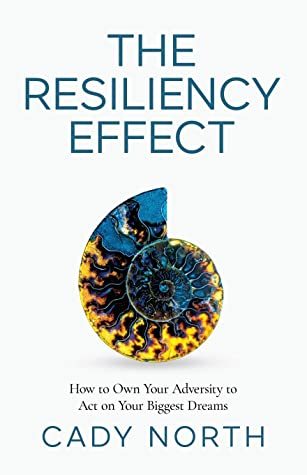 The Resiliency Effectby Cady North
The Resiliency Effectby Cady NorthGiveaway ends April 26, 2021.
See the giveaway details at Goodreads. Enter Giveaway
March 18, 2021
How Does The Status Quo Bias Impact Our Dreams?
One of the biggest challenges in acting on our big dreams is this: it’s a part of our human nature to focus on self-preservation. Our fear of making big changes has been explored in scientific studies about behavioral economics. William Samuelson and Richard Zeckhauser first proved the existence of a human, “status quo bias,” in experiments conducted in the late 80s.
Participants were asked in a series of hypothetical questions about how they would react given a set of facts. The study found that it was most common for participants to answer with the choices that involved doing nothing new or maintaining their current or previous decision. This bias to focus on the status quo is often observed in real life. Think about the last time you choose from three or four different health plans at work. Did you go with the default? The one you chose last year? If you’re like most consumers, you choose the plan you knew or were familiar with (i.e. the safe option) or the one that was the default or middle ground (required less decision-making.)
It takes extra work to discover the pros and cons of the new health care plan on the list. It also opens you up for the potential to “choose wrong.” The fear of loss is weighed more heavily by the mind than the potential for finding new gains by choosing a new plan. Weighing losses more than potential positives is also a human tendency observed in behavioral economics, known as the “loss aversion bias.”
Status Quo Works Against Our Big DreamsThe same thing happens with us and our dreams for our life. We can often name what our big dreams are to our friends or our mentors and advisors. However, we often immediately discount or let go of them because the “safe” thing to do is to maintain the status quo. It’s a path we know well. Adding something uncertain to the mix can create fear of loss or be demotivating. An easy response to acting on our dreams would be to say, “not now,” because that lets us hold on to the dream while letting us off the hook for not taking any action toward achieving the big goal.
It’s also much easier to focus outwardly on the external journey of “adulting,” paying our bills, moving through a career progression, buying a house, having a family, and generally “doing what we’re supposed to be doing.” This represents the status quo. Working a new big project that fulfills a passion, taking a sabbatical, or changing a career to do something more fulfilling all represent a departure from the norm and the status quo. We avoid the hard work trying to examine whether our “adulting” and keeping to the status quo in our life decisions hurts or helps us getting to our big dreams.
Yet, simply being aware that we all have a bias toward keeping the status quo or averting potential loss is not enough to fix the flaws in our decision making.
The Inner JourneyThat’s why I advocate for lessening the focus on the outward journey and instead focusing on the inner journey, so that we cannot just name our biggest dreams, but go about living them.
“It is easy – maybe too easy – to stop asking yourself what would make you happy and stay close to the things that you think will make you safe,” Sady Doyle, a feminist author once wrote. “This is wrong, and I will tell you why: you are never safe. Loss and change are constants. You will never be safe, and you may not always be happy – but you owe it to yourself to start asking the question.”
How do we start getting comfortable asking, “What will make me happy?” and trust the answer. How do we begin to feel OK making decisions which might take us away from the safe zones of what we know into the potential unsafe places of the unknown that represent our big dreams? The answer is inner work.
For some people this inner work may be about discovering lost memories, analyzing trauma in your life whether from childhood or adulthood. For many of us we have to learn how to be safe being vulnerable with our loved ones. Still others may need to learn to get comfortable with the gifts they already have, or work against imposter syndrome.
Success CatalystsAs I prepared to write The Resiliency Effect I researched or interviewed more than 50 people. I included those from the LGBTQ+ community, black people and other people of color. The common denominator of the women I profiled was that they made a big change to live a life more in sync with their purpose and passions.
They had untapped potential and found the courage to harness their creativity, their values, and a vision for creating a better community around them. The majority of them also experienced a period of burnout prior to making the big change. What I learned as I researched is that there were some common sources for their resiliency.
Many of them required a complete break or sabbatical from work to get their mindset right. Some of them spoke openly about work they had done in therapy to discover how adversities they, or their families, experienced were impacting them and creating limiting beliefs today. All of them spoke about self-reflection and discoveries they made about what truly provides energy and purpose in their lives. More than half pursued self-employment. More than half of those who are self-employed did so by changing their career path.
The book details four common themes from these discussions about resiliency: how to unlearn coping mechanisms, how being vulnerable can be a catalyst for change, the role cross functional learning plays in success, and ways to unearth and lean into your passions in life. As the people I profiled made these big changes in life, a side effect was that they found not just outward success in whatever path they chose, but had developed more emotional wealth too.
Grab a copy of the book to explore questions for reflection at the end of each chapter that will help you on your journey.



